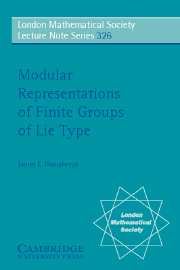Book contents
- Frontmatter
- Contents
- Preface
- 1 Finite Groups of Lie Type
- 2 Simple Modules
- 3 Weyl Modules and Lusztig's Conjecture
- 4 Computation of Weight Multiplicities
- 5 Other Aspects of Simple Modules
- 6 Tensor Products
- 7 BN-Pairs and Induced Modules
- 8 Blocks
- 9 Projective Modules
- 10 Comparison with Frobenius Kernels
- 11 Cartan Invariants
- 12 Extensions of Simple Modules
- 13 Loewy Series
- 14 Cohomology
- 15 Complexity and Support Varieties
- 16 Ordinary and Modular Representations
- 17 Deligne–Lusztig Characters
- 18 The Groups G2(q)
- 19 General and Special Linear Groups
- 20 Suzuki and Ree Groups
- Bibliography
- Frequently Used Symbols
- Index
8 - Blocks
Published online by Cambridge University Press: 23 November 2009
- Frontmatter
- Contents
- Preface
- 1 Finite Groups of Lie Type
- 2 Simple Modules
- 3 Weyl Modules and Lusztig's Conjecture
- 4 Computation of Weight Multiplicities
- 5 Other Aspects of Simple Modules
- 6 Tensor Products
- 7 BN-Pairs and Induced Modules
- 8 Blocks
- 9 Projective Modules
- 10 Comparison with Frobenius Kernels
- 11 Cartan Invariants
- 12 Extensions of Simple Modules
- 13 Loewy Series
- 14 Cohomology
- 15 Complexity and Support Varieties
- 16 Ordinary and Modular Representations
- 17 Deligne–Lusztig Characters
- 18 The Groups G2(q)
- 19 General and Special Linear Groups
- 20 Suzuki and Ree Groups
- Bibliography
- Frequently Used Symbols
- Index
Summary
Block theory plays a fundamental role in modular representation theory of finite groups (and has been imitated profitably in other non-semisimple situations). For a finite group G, the blocks of KG can be defined straightforwardly to be the indecomposable two-sided ideals; but their structure may be quite complicated when p divides |G|. Each simple (or, more generally, indecomposable) KG-module “belongs to” a unique block. There are also important connections with the representations of G in characteristic 0. Brauer theory shows that any reduction modulo p of a simple ℂG-module yields well-defined composition factors over K, all of which belong to the same block. (This theme is pursued in Chapter 16 below.)
There are many ways to approach the determination of blocks of KG for a particular group G, depending on what is already known about the ordinary and modular representations. Here we review some basic theory involving the defect of a block (8.2) and the associated defect groups (8.4), then apply it to a group of Lie type in the defining characteristic. It turns out in this case that KG has blocks of only two extreme types. One type involves just the Steinberg module, while the other type has “defect group” equal to a Sylow p-subgroup (8.5). In particular, when G is simple it has precisely two p-blocks. This result can also be placed in the more general setting of “vertices” of simple modules (8.8).
- Type
- Chapter
- Information
- Modular Representations of Finite Groups of Lie Type , pp. 67 - 74Publisher: Cambridge University PressPrint publication year: 2005



